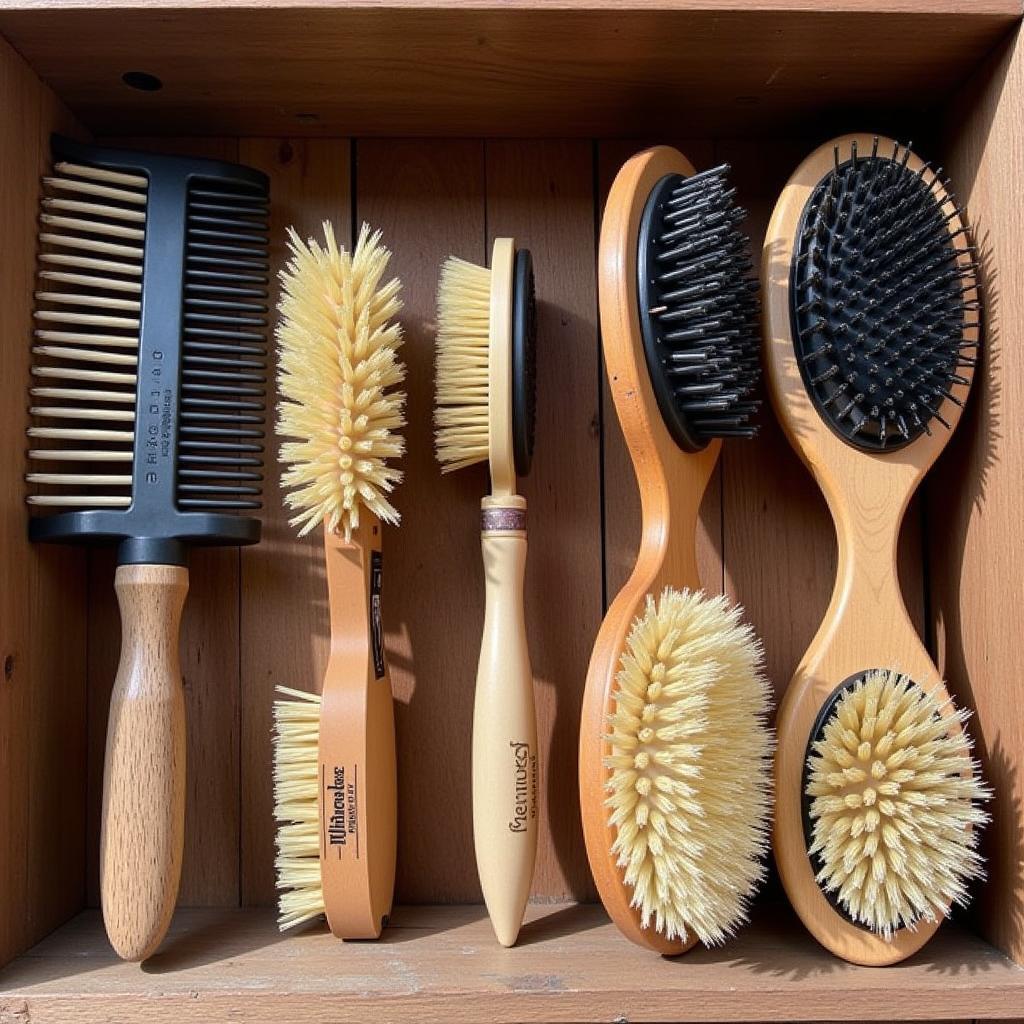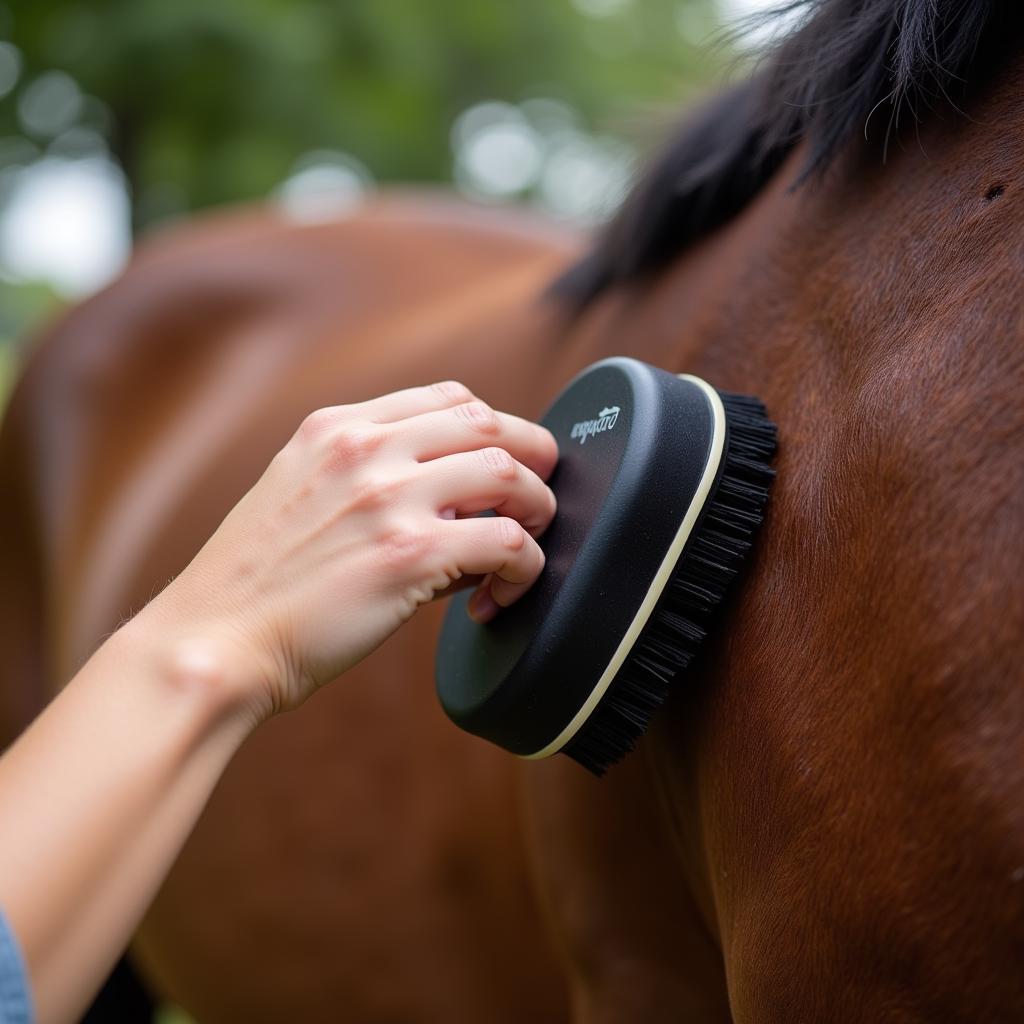Grooming is an essential aspect of horse care, not just for their appearance but also for their overall health and well-being. A good grooming routine strengthens the bond between you and your horse while also allowing you to check for any injuries or skin conditions. And at the heart of every good grooming session lies the Best Horse Brush for your equine partner.
With a plethora of horse brushes flooding the market, choosing the right one can be overwhelming. Do you need a curry comb, a dandy brush, or a body brush? What about those fancy brushes with synthetic bristles? This comprehensive guide delves into the world of horse brushes, equipping you with the knowledge to make the best choice for your horse’s coat care.
Understanding Different Types of Horse Brushes
Before we dive into specifics, let’s break down the common types of horse brushes and their uses:
- Curry Comb: Often made of rubber or plastic, curry combs are the workhorses of grooming. Their primary function is to loosen dirt, dust, and loose hair.
- Dandy Brush: Characterized by long, stiff bristles, usually made from plastic or natural fibers like rice straw, dandy brushes are perfect for removing the dirt and hair lifted by the curry comb.
- Body Brush: With softer bristles than dandy brushes, body brushes are used to remove finer dust and debris, leaving a polished finish on your horse’s coat.
- Face Brush: As the name implies, these smaller, softer brushes are designed specifically for the sensitive areas of your horse’s face.
- Mane and Tail Brush: These brushes are specifically designed to detangle and smooth the mane and tail, often featuring widely spaced bristles or teeth.
 Horse Grooming Brushes
Horse Grooming Brushes
Choosing the Best Horse Brush: Factors to Consider
Selecting the right horse brush depends on several factors:
- Your Horse’s Coat: Is your horse’s coat fine and silky or thick and coarse? Different brushes are suited to different coat types. For instance, a soft body brush may be sufficient for a fine-coated horse, while a horse with a thicker coat might benefit from a stiffer dandy brush.
- Sensitivity: Some horses are more sensitive than others. If your horse has sensitive skin, opt for brushes with softer bristles and avoid using curry combs on bony areas.
- Season: During shedding season, you’ll need brushes that can effectively remove loose hair. Consider a shedding blade or a rubber curry comb for this purpose.
- Your Budget: Horse brushes range in price from budget-friendly to quite expensive. Set a budget before you shop and prioritize quality and functionality.
Using Your Horse Brush: Tips for Effective Grooming
Using the right techniques can enhance the effectiveness of your chosen horse brush:
- Start with a Curry Comb: Always begin your grooming routine with a curry comb to loosen dirt and hair. Use circular motions, applying moderate pressure.
- Follow with a Stiff Brush: After using the curry comb, employ a dandy brush to flick away the lifted dirt and hair. Use long, sweeping strokes in the direction of hair growth.
- Finish with a Soft Brush: Complete the grooming process with a body brush to remove any remaining dust and provide a final polish to the coat.
- Don’t Forget the Face and Hooves: Use a dedicated face brush for the sensitive skin on your horse’s face. And don’t neglect hoof care – use a hoof pick to remove dirt and debris from your horse’s hooves.
 Grooming a Horse with a Brush
Grooming a Horse with a Brush
Maintaining Your Horse Brushes
Proper maintenance ensures your brushes last longer and perform optimally:
- Clean After Each Use: Remove loose hair and dirt from the bristles after every grooming session. You can use a brush cleaner or a simple comb for this purpose.
- Wash Regularly: Wash your brushes with warm, soapy water at least once a month. Rinse thoroughly and allow them to air dry completely.
- Store Properly: Store your brushes in a clean, dry place to prevent mold and mildew growth.
FAQs about Horse Brushes
Q: Can I use a human hairbrush on my horse?
A: It’s not recommended to use human hairbrushes on horses. Human hairbrushes are not designed for the coarseness and thickness of horsehair and may not effectively remove dirt and debris.
Q: How often should I brush my horse?
A: Ideally, you should groom your horse daily, even if it’s just a quick brush. Regular grooming helps maintain a healthy coat, strengthens your bond, and allows you to check for any issues.
Q: My horse hates being brushed. What can I do?
A: Some horses may be sensitive to touch. Start slowly, introducing the brush gradually. Use gentle strokes and reward good behavior with treats and praise.
Choosing the Right Brush for a Happy Horse
Choosing the best horse brush is a matter of understanding your horse’s individual needs and your grooming preferences. By investing in high-quality brushes and employing proper grooming techniques, you can ensure a shiny, healthy coat for your equine companion. And remember, grooming is not just about aesthetics; it’s a vital part of horse care that fosters a deeper bond between you and your horse.
For more information on horse care essentials, check out our articles on cleaning horse hair brushes and the best horse saddle pads.
Remember, a happy horse is a well-groomed horse!
Need help finding the best grooming tools? Contact us at 0772127271, email us at [email protected], or visit us at QGM2+WX2, Vị Trung, Vị Thuỷ, Hậu Giang, Việt Nam. Our dedicated team is available 24/7 to assist you.